| Tips, Tricks, Info |
Tips, Tricks, Info
Fakes & Franken - Hints For Buying A Vintage-RADO:
#General:
Buying a vintage watch, you always should be very cool-headed, critical and attentive. If you want to purchase a vintage RADO, you should be specifically careful. The market for vintage Rados is flooded with so called "Franken-RADOs", often hardly to differ from authentic models.
And since the late 1970s, more and more fakes have popped up on the market, more or less cheap made replicas, offered for a small budget or even dishonestly as authentic. In the beginning, those fake RADOs were easily to identify, but meanwhile, some of these fakes are so "good", that they are hardly to recognise without an authentic RADO model aside for compare or opening the watch. As soon as such a fake watch is opened, the similarity with the authentic model ends abruptly - cheapest quartz or automatic movements from China work there. And scratchproof case materials as ceramic or sapphire crystals can´t be really found on those fakes - after a short time already they show clear traces of wearing. In Germany and many other countries, production, commercial and private sale of those bootlegs are illegal anyway.
But there are some simple rules to avoid bad buys:
- if an opportunity seems to good to be true, it is almost too good to be true.
- new watches should be purchased from absolutely confidential contractors only, a research in the internet can help.
- used watches, vintage or newer models shouldn´t be bought without having seen a pic of the movement.
- at vintage watches, even the smallest detail should be examined, pictures of the same model can be found in the internet for a detailled comparison. Pics of watches in obviosly used condition are almost more reputable than high glossy pics of apparently immaculate watches. Good pics for compare can be often found on collectors´ homepages - especially in Japan there´s an interesting collectors´ scene.
- eyes wide open if it comes to gaudy colours or bicoloured dials - nearly all of them are refinished. Also black dials require special attention - they are highly sought after and so there are much more black dialed RADOs on the market than ever have been made.
The following infos may also help you a little bit to analyse the authenticity of a vintage Rado:
# Franken-RADOs:
Most people know Mary Shelley´s story of Dr. Frankenstein, the crazy scientist, who created a living human being from parts of bodies. So a "Franken-RADO" is a RADO, assembled with parts of original but partly defect or worn out watches, often from different models. Frequently, heavily scratched case parts are grinded and/or polished beyond all recognition. Dials are frequently refinished and reprinted, often incorrect and with wrong model names. Or dials in acceptable condition are simply combined with cases and/or movements from other models. The movements are often replaced by other ones or ones being assembled with parts from different defect movements. For fans and collectors of vintage watches, these "Frankens" are a no-go, authenticity has absolute priority.
With the heavily increasing prices of vintage RADOs inner the last 20 years, that became an interesting and profitable business model. Especially Fareast was and is a strong market for RADO, so you find there large quantities of defect, worn out watches - or what remained of them. The wages for watchmakers and technicians are ridiculous there in compare to Europe, the USA or other industrialised countries. So, many, many "Franken-RADOs" are produced and offered for a lot of money at international sales platforms as Ebay or traded to resellers, who offer them in their countries with a good profit. And if such a watch once is complainted and sent back, the next one will buy it. For a layman, these watches are hardly to recognise and the tremendous variety of RADO´s vintage watch models doesn´t makes it easier to get an overview. Some customers will never notice that they haven´t bought an authentic RADO, others notice only time after the purchase that something´s wrong with their watch. They either don´t care about then or try to resell it as soon as possible without a financial loss.
Here is an example of a typical "Franken-RADO":
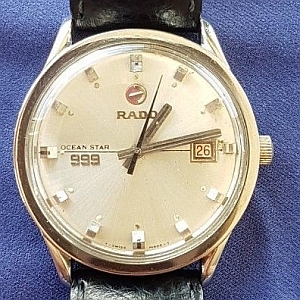 1.
1. 2.
2.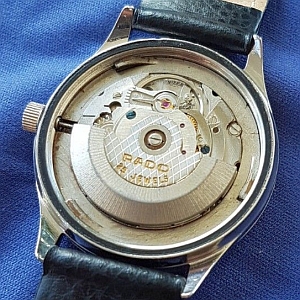 3.
3.
On the first view, this RADO Ocean Star 999 doesn´t look bad. Indeed - there never had been a RADO Ocean Star 999. Ocean Star is a model name used by Mido. Reprinting the refinished dial, they simply took the wrong stamp for printing (the RADO typing and the cyphers "999" of the model name are from metal and applicated). Actually it is a RADO Starliner 999 from the middle of the 1960s.
- Dial refinished and reprinted with the wrong model name (instead of the correct name Starliner Mido´s model name Ocean Star) and with "T Swiss Made T" (T for Tritium as luminous paint for hands and markers from 1960 on), also from the Mido Oceanmaster. The dots from luminous paint at the markers don´t belong there, the original dial shows "Swiss Made" only and there is no luminous paint, neither at the markers nor on the hands. BTW, which sense make luminous dots at the markers if the hands are not luminous? The hands are not original and the ramp-shaped markers with the black line on the inclined inner side have been mounted the wrong way round (with the inclined side outside, good to see at 9). Also the crown is not original (too large) and the case is polished.
- The octagonal bayonet case back, probably heavily scratched before, was grinded and polished beyond all recognition.
- The original movement, an AS 1789, was replaced by an ETA 2824 from the 1970s.
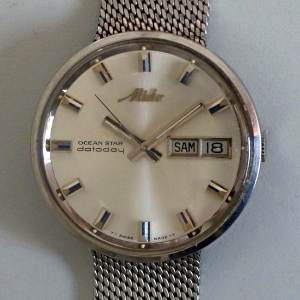 1.
1.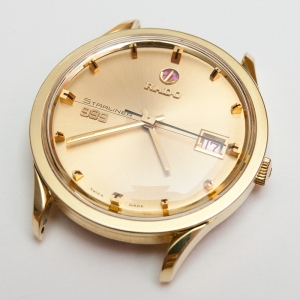 2.
2.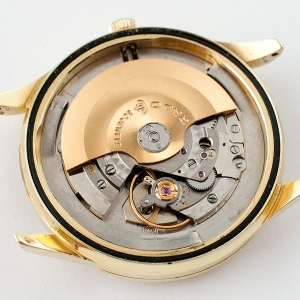 3.
3.
- Original Mido Ocean Star
- Original RADO Starliner 999, gold plated version
- The original movement, an AS 1789
Also my first RADO had been a "Franken-RADO" - and I still own it. But that´s been many years ago and I simply hadn´t had a clue about vintage RADOs at that time. Some nice vintage RADOs could be bought for 20, 30 € at Ebay back then. Meanwhile, it received two original companions.
 1.
1.  2.
2.
My RADO Starliner (1.) actually had been a Spherematic (2.) with a refinished dial and reprinted with the wrong model name. Today, alone the matt black lacquer of the dial and the poor printing quality of the model name and the "Swiss Made" would ring my alarm bells. Except the dial and the crown (too large), at least the rest including the AS 1701 automatic movement had been in an original and good condition.
# Crystal:

Genuine RADO-crystals from acrylic/Plexi wear the small anchor-logo in the center, ca. 1960s up to mid of the 1970s (exceptions known).
# Crown:
From ca. middle of the 1950s, all RADO-crowns are signed.

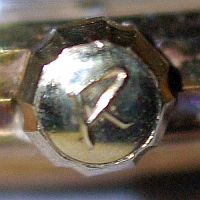
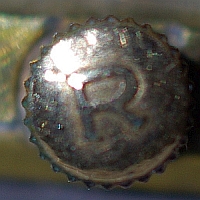

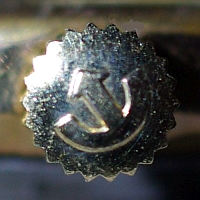
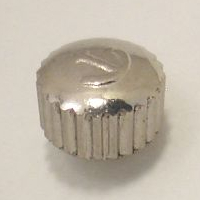
Signed Rado-crowns: From middle of the 1950s signed with an "R" (early version italic, later versions straight, then serif), from 1957 with the anchor logo. Probably because of a large stock, both versions had been used for a longer interim-period, probably up to middle of the 1960s.
# Case-Back:
Nearly all Rado case backs later than 1957 are marked, nearly always, there´s a reference number on it, e.g. 12345 (5-digit, 1957 - 1971) or 123.4567.8 (8-digit, from 1972), sometimes the model name. That should match the dial. Unfortunately there is no complete register of those reference numbers, a lot of them can be asked for at the vintage RADO-Forum.
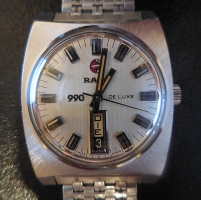
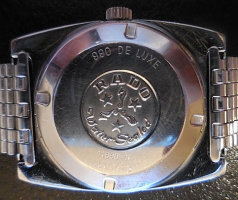
990 De Luxe: Dial and back match (reference-no. 11860 is also correct).
# Movement:
Nearly every Rado movement/every Rado movement after 1957 is marked, all bridges and other parts should show the same aging and colour(exception: Some movements of the late 1950s, beginning 1960s are bicolour, guilt/silver). Otherwise parts have been replaced or the movement is a new combination of old parts.

At this AS 1858 e.g., the automatic bridge(under the rotor) is replaced(silver instead of golden) and the balance bridge(different gold colour).
RADO-Infos:
# Chart 8-digit RADO Reference-number:
Around middle of the 1950s, Rado started with 5-digit reference numbers.
From 1972/73 on, the old reference numbers (12345) had been replaced by new ones with 8 digits (123.4567.8).
>>>The first three digits(123.xxxx.x) show the caliber of the movement:
| 123.xxxx.x: | Movement: |
| 104 | ? Quartz |
| 105 | ? Quartz d |
| 107 | ? Quartz, d |
| 108 | ESA/FHF 765.321, Quartz, d/d |
| 111 | ? Quartz, d |
| 113 | ESA/ETA 955.411, Quartz, d, 10½''' |
| 114 | ESA/ETA 955.421, Quartz, d/d, 10½''' |
| 115 | ESA/ETA 955.112, Quartz, d, 11½''' |
| 119 | ? Quartz |
| 121 | ESA/ETA 956.431, Quartz, 8¾''' |
| 129 | ESA/ETA 956.411 or 412, Quartz, d, 8¾''' |
| 132 | ? Quartz |
| 133 | ? Quartz |
| 150 | ? Quartz |
| 152 | ESA/ETA 256.111, Quartz, d, 8¼''' |
| 153 | ? Quartz |
| 156 | ESA/ETA 255.411, Quartz, d, 10½''' |
| 157 | ? Quartz, d |
| 160 | ? Quartz, d |
| 161 | ? Quartz, d |
| 193 | ? Quartz Multifunctional |
| 196 | ? Quartz Multifunctional |
| 204 | ? Quartz |
| 210 | ? Quartz Multifunctional |
| 290 | ? Auto, digital |
| 291 | ? Quartz, d |
| 303 | ETA 1977, HA ? |
| 305 | ? |
| 318 | ESA/ETA 980.106, Quartz, 5½ x 6¾''' |
| 322 | ? Quartz |
| 393 | FHF 67, HA, 10½''' |
| 396 | Peseux 7001, HA, 10½''' |
| 406 | ETA 2651, HA, d, 7¾''' |
| 437 | ETA 2852, HA, d, 11½''' |
| 448 | ETA 2769, HA, d/d, 11½''' |
| 538 | ? Quartz Chronograph |
| 539 | ? Quartz-Chronograph |
| 541 | ESA/ETA 251.262, Quartz Chronograph, 13¼''' |
| 556 | ? |
| 557 | ETA 2671, Auto, d, 7¾''' |
| 558 | ETA 2671, Auto, d, 7¾''' |
| 559 | ? |
| 561 | ETA 2671, Auto, d, 7¾''' |
| 562 | ETA 2678, Auto, d/d, 7¾''' |
| 565 | ETA 2671, Auto, d, 7¾''' |
| 569 | ? |
| 577 | ? |
| 580 | ETA 2681, Auto, d, 8¾''' |
| 587 | AS 1876, Auto, d/d, 11½''' |
| 589 | ? |
| 596 | ? |
| 597 | ESA/ETA 205.911, Auto-Quartz (generator and accu) |
| 603 | ETA 2878, Auto, d/d, 11½''' |
| 605 | ETA 2872, Auto, d, 11½''' |
| 606 | ETA 2836, Auto, d/d, 11½''' |
| 619 | ? |
| 623 | ETA 2783, Auto, d, 11½''' |
| 625 | ETA 2789, Auto, d/d, 11½''' |
| 629 | ETA 2892-2, Auto, d, 11½''' |
| 631 | ? |
| 633 | ETA 2824, Auto, d, 11½''' |
| 634 | ? Auto, d |
| 636 | ETA 2836-2, Auto, d/d, 11½''' |
| 646 | ? |
| 648 | ETA 2836-2, Auto, d/d, 11½'''(newer version) |
| 650 | ETA 2894-2, Auto, d, Chronograph, 12½''' |
| 656 | ? Auto, d |
| 658 | ETA 2824-2, Auto, d, 11½''' |
| 663 | ETA 7770 Auto, Chronograph Rattrapante(split second), (Basis ETA 7750), 13¼''' |
| 674 | ETA (Valjoux) 7750, Auto Chronograph, d/d, 13¼''' |
| 680 | AS 5008, Auto Alarm, d/d |
| 711 | ESA/FHF 935.112, Quartz, d |
| 717 | ? Quartz |
| 719 | ESA 951.111, Quartz, d |
| 729 | ? Quartz d |
| 732 | ? Quartz d |
| 738 | ESA/ETA 955.??? Quartz d |
| 739 | ESA/ETA 955.??? Quartz d/d |
| 740 | ESA 9162, tuning fork d |
| 742 | ESA 9164, tuning fork d/d |
| 756 | ESA 9181, Quartz, d/d |
| 763 | ETA C07.611, Auto, d, 11½''' ("Powermatic 80", based on 2824-2) |
| 764 | ETA C07.621, Auto, d/d, 11½''' ("Powermatic 80", based on 2824-2) |
| 773 | ETA C07.881, Auto, subsecond, d, 11½''' ("Powermatic 80", based on 2824-2) |
| 778 | ESA 9315, Quartz digital LCD |
| 780 | ? Quartz Chronograph digital LCD |
| 836 | ? Auto d/d |
| 848 | ? Auto, d |
| 963 | ? Quartz |
| 964 | ? Quartz, magnetic pen instead crown |
| 999 | AS 1901(1900-01), HA, d, 11½''' |
| incomplete, will be completed | |
| HA = manual winded, Auto = Automatic | |
| d = date, d/d = day and date |
More information about single movements here, at Dr. Ranfft´s Movement Register or at Christoph Lorenz´s Register
>>>The next 4 digits(xxx.4567.x) identify the model..
>>>The last digit(xxx.xxxx.8) shows the case material:
| 1 | From 1982: Stainless Steel |
| 2 | Gold Plated |
| 3 | Tungstencarbide |
| 4 | Up To 1982: Stainless Steel |
| 4 | From 1982: High Tech Ceramics |
RADOs with cases from real gold always wear a gold puncheon.
# Anchor-Logo - moveable or not? 
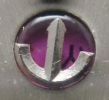

Moving anchor-logo: On RADOs with automatic or electromechanical movement.
Static or printed anchor-logo: On RADOs with manual winded, quartz or automatic movement (automatic movement: only at early automatics or later only in combination with a real gem-dial(tiger-eye, opal etc.) - and later automatics(from 1980s)
The moving anchor is just moveable, there´s no mechanical connection to the movement(only exception: The 1970s automatic Chronograph with anchor as small second). If there is some dust in the bearing, they almost stop moving, so it needs to be disassembled and cleaned or replaced. Silver/stainless steel cases have a silver anchor, gold plated or gold ones have a gold plated anchor. More info about the moving anchor-logo below.
# History of the RADO-Logos:
 > ? - 1950: old serif typing
> ? - 1950: old serif typing
 > Also known before 1950: RADO typing in script italic on the dial.
> Also known before 1950: RADO typing in script italic on the dial.
 > 1950 - 1957: "R-line"-logo with italic typing
> 1950 - 1957: "R-line"-logo with italic typing
 > 1957 - today: anchor-logo, serif typing
> 1957 - today: anchor-logo, serif typing
From the beginning in 1937 up to 1950, RADO used a serif logo-typing similar to the current one: 
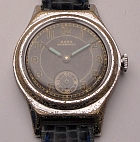
Also known: RADO in script typing: 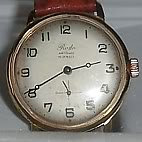
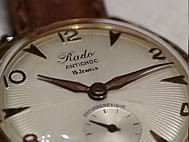
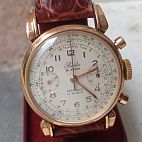
1951, the "R-line"-logo came: 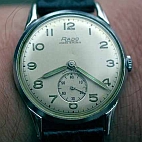
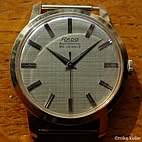
1957, Schlup & Co. gave up the Exacto-brand and concentrated on RADO. The old logo-typing was modified and replaced the "R-line" one.
At first, the watches had only the RADO serif typing as logo on the dial: 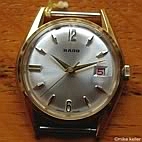
Automatic watches wore the addition "Automatic": 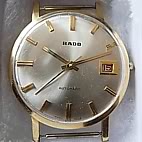
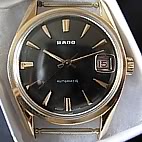
Then they decided to use the additional anchor for automatics: 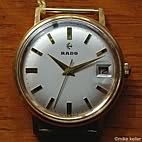
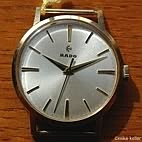
At last, the moving anchor (patented 1958) was developed for automatics: 

The printed or fix anchor now was used for manual winded ones: 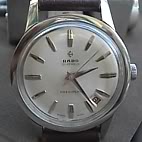

Parts on stock were used up, so inner an interim period, you find old and new logos side by side, also very rare design mixes:
Extremely rare: Mix of old dial with "R-line"-logo and moving anchor on a 14 kt gold automatic watch (Jubilar): 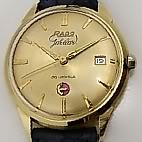
As rarely as well seen: Old dial with "R-line"-logo and static anchor on a manual winded De Luxe model:
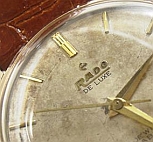
Absolute rarity, completely original - time warp with a watch: 14 kt solid gold ref. 11568, dial with old RADO-logo before 1950, back with "R-line"-logo and movement (AS 1580) with new logo and anchor:
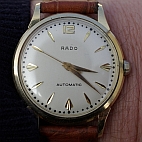
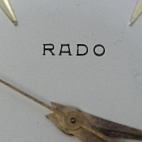
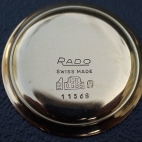
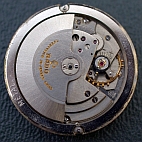
# Seahorses-Logo:
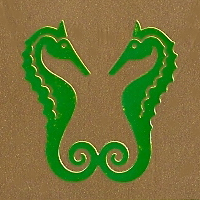
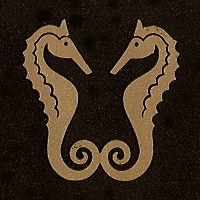
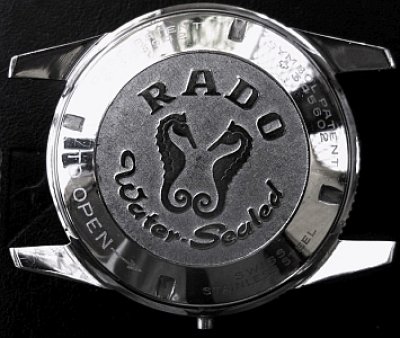 1957 - today, seahorses-logo
1957 - today, seahorses-logo
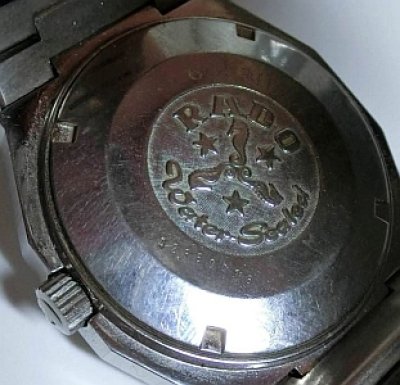 later also with 3 seahorses
later also with 3 seahorses
# Moving Anchor Logo (symbol patent): 
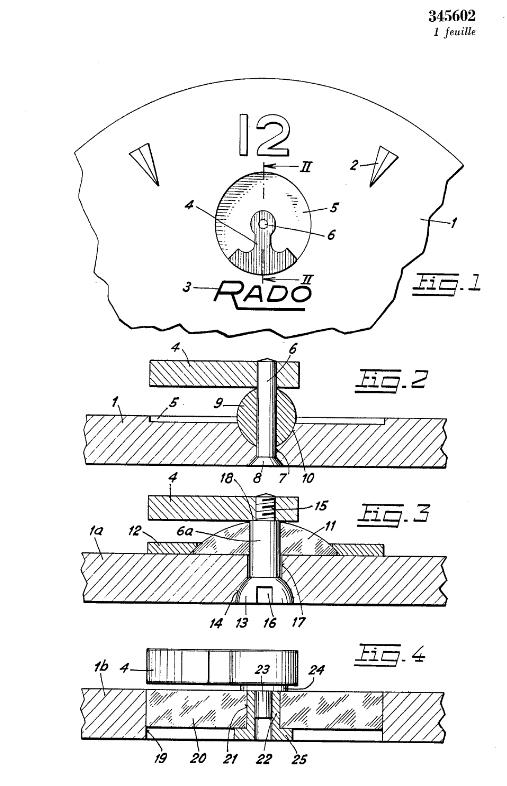
 Pic: Moving anchor-logo, jewel
Pic: Moving anchor-logo, jewel
Technical sketch: Three versions of the red moving anchor-logo (from the apply for patent). The moving anchor logo has been used since 1958 on watches with automatic winding or electromechanical movements.
After the patent specification, the moving anchor logo isn´t just a gimmick, but also a service indicator for the movement. If the oil in the bearing of the moving anchor logo is gone and the anchor doesn´t move freely, the oil in the movement is gone, too and the movement needs a service. Up to ca. middle/end of the 1960s, the moving, red, round platform, which carries the small anchor, was made of synthetic ruby like the jewels in the movement. Later they were made from red finished metal.
 Pic: Moving anchor-logo from inside dial
Pic: Moving anchor-logo from inside dial
# Bayonet Case Back (case patent):
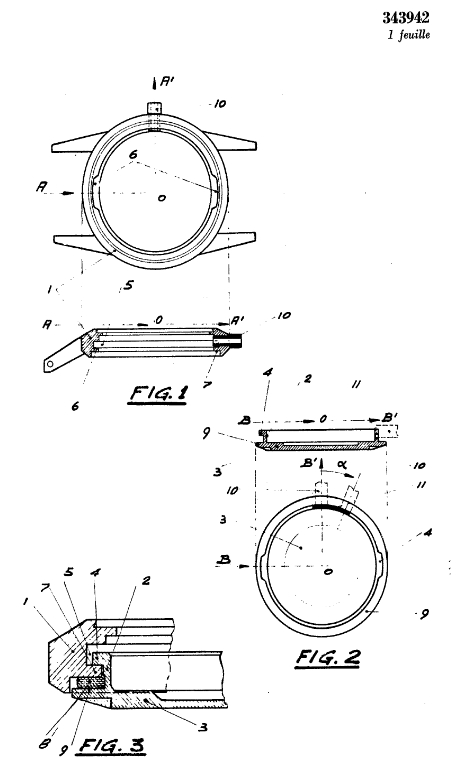
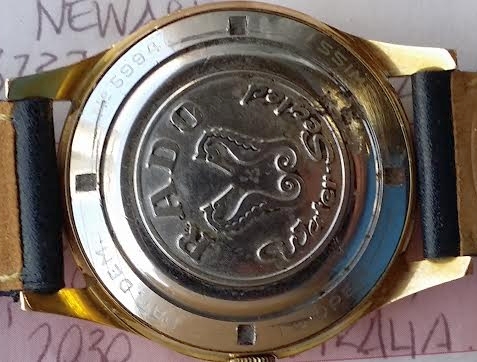
Technical sketch: Bayonet back being used by Rado end of 1950s to end of 1960s (from the apply for patent) Pic: Early version of the bayonet case back (patent demanded)
At least, the final version has three instead of two tappets (as in the technical sketch), gripping into the setting of the watch case to fix the back. End of 1960s they switched to screw down backs, these wear three instead of two seahorses.
ATTENTION! The bayonet case back is to be turned 30° only at opening/closing. ATTENTION!

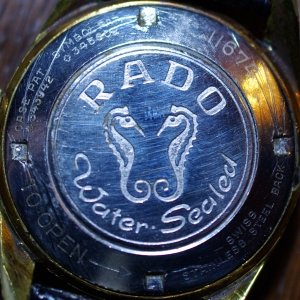
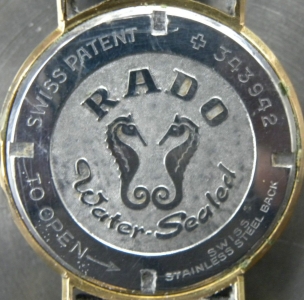

Bayonet case backs - domed/engraved, plain/embossed, later domed octogonal/embossed
# RADO DiaStar Info "scratchproof":
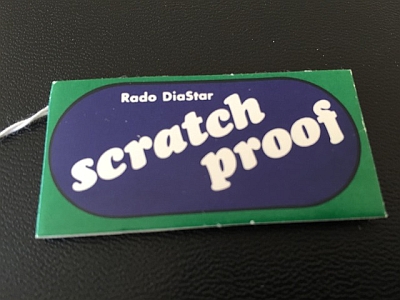 a
a b
b
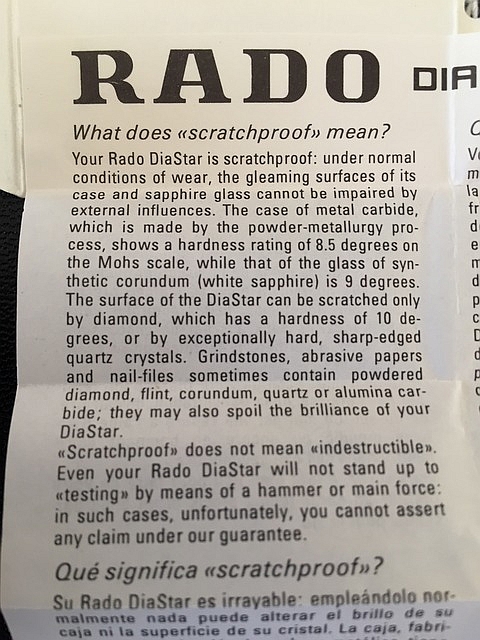 c
c
a,b +c: ©John Patterson
# Instruction: Setting Day and Date, RADO Daymaster:
The first RADO Daymaster (day/date) models don´t have a quickset.
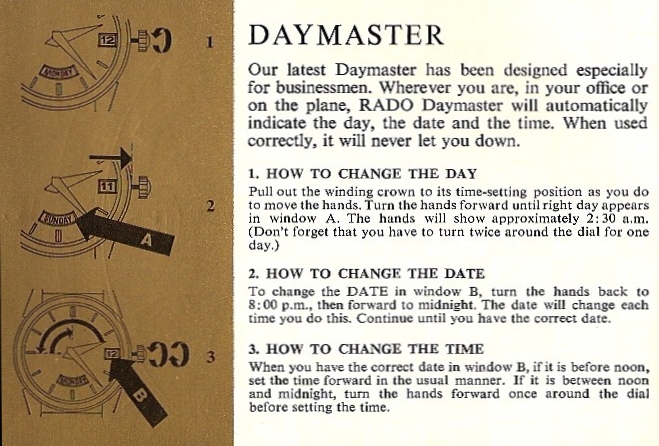
# RADO´s latest Instruction Manual, latest Catalogue
Instruction Manual:
Download-Link(pdf) from the official RADO HP
Latest Catalogue:
Download-Link(pdf) from the official RADO HP
You will need a pdf-viewer as Adobe Reader or Nitro Reader to watch these infos.
Verantwortlich für den Inhalt dieser Seite ist ausschließlich der
Autor dieser Homepage, kontaktierbar über dieses Formular!



